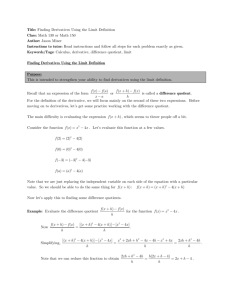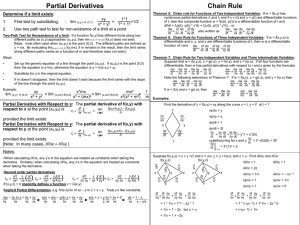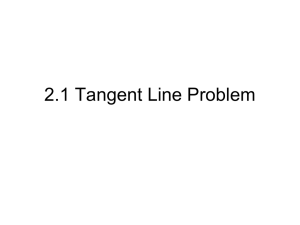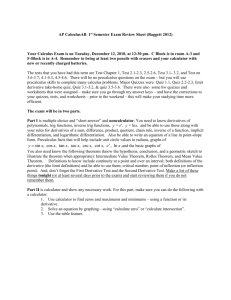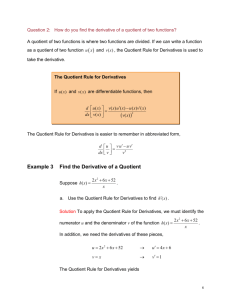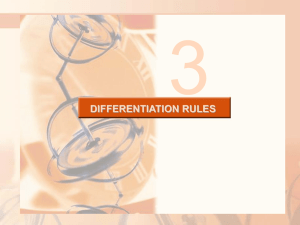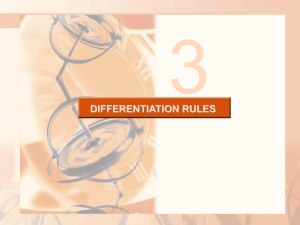View Notes as Powerpoint Presentation
advertisement
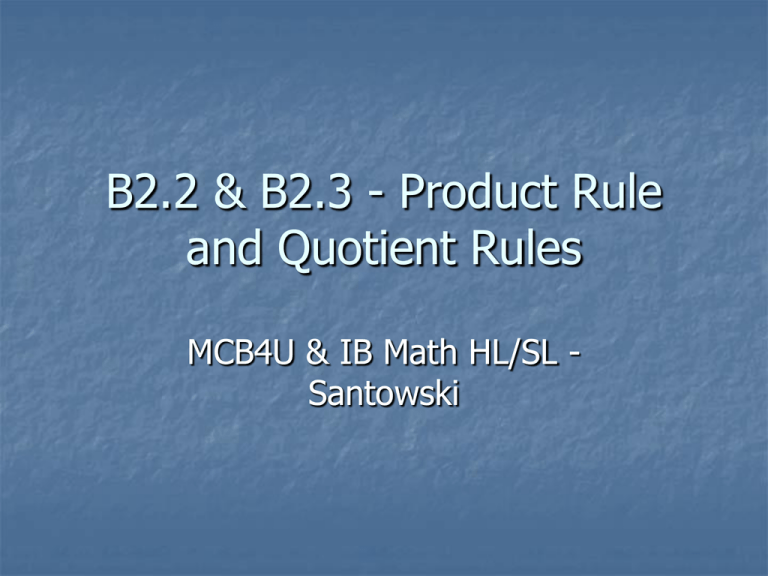
B2.2 & B2.3 - Product Rule and Quotient Rules MCB4U & IB Math HL/SL Santowski (A) Review The derivative of a sum/difference is simply the sum/difference of the derivatives i.e. (f + g)` = f ` + g` The power rule tells us how to find the derivative of any power function y = xn which works for any real value of n (B) Product Rule – An Investigation Now the question concerns products of functions is the derivative of a product of functions the same as the product of the derivatives? i.e. is (fg)` = f` x g` ?? Let's investigate with a product function h(x) = f(x)g(x) where f(x) = x² and g(x) = x² - 2x. Thus h(x) = x²(x² - 2x) (B) Product Rule – An Investigation Trial 1 if we go with our idea that (fg)` = f` x g` then (fg)` = (2x)(2x - 2) = 4x² - 4x We can graph h(x) on the GC, graph the derivative and then program in 4x² - 4x and compare it to the calculated derivative from the GC. We will find that the two do not match up!!! If we simply tried expanding h(x) = x4 - 2x3 and then taking the derivative, we would get 4x3 – 6x2. If we program 4x3 – 6x2 into the GC, we find that we match the GC generated derivative exactly. (B) Product Rule – An Investigation (C) Power Rule - Derivation So why does (fg)` = f ` x g` not work? Let’s go back to limits and basic principles to find what the differentiation technique should be if we wish to find a derivative of a product Let K(x) = [f(x)] x [g(x)] Then K `(x) = lim h0 1/h[K(x + h) – K(x)] And K `(x) = lim h0 1/h [ f(x+h)g(x+h) – f(x)g(x)] which gets simplified as on the next slide: (C) Power Rule - Derivation K ( x) lim h 0 K ( x) lim K ( x h) K ( x ) h f ( x h) g ( x h) f ( x ) g ( x ) h 0 K ( x) lim h f ( x h) g ( x h) f ( x h) g ( x ) f ( x h) g ( x ) f ( x ) g ( x ) h 0 h g ( x h) g ( x ) f ( x h) f ( x ) K ( x) lim f ( x h) g ( x) h 0 h h K ( x) lim f ( x h) lim h 0 h 0 g ( x h) g ( x ) h K ( x) f ( x) g ( x) g ( x) f ( x) lim g ( x) lim h 0 h 0 f ( x h) f ( x ) h (D) Power Rule - Examples ex 1. Find the derivative of f(x) = 3x4(5x3 + 5x - 7) ex 2. Find the derivative of f(x) = (x4-4x3–2x2+5x+2)2 ex 3. Find the equation of the tangent to the function f(x) = (2x + 4)(3x3 – 3x2 + x - 2) at (1,-6) (E) Derivatives of Rational Functions – The Quotient Rule Since the derivative of a product does not equal the product of the derivatives, what about a quotient? Would the derivative of a quotient equal the quotient of the derivatives? Since quotients are in one sense nothing more than products of a function and a reciprocal we would guess that the derivative of a quotient is not equal to the quotient of the derivatives (F) Quotient Rule - Derivation First, set up a division and then rearrange the division to produce a multiplication so that we can apply the product rule developed earlier H ( x) f ( x) g ( x) f ( x) H ( x) g ( x) f ( x ) H ( x ) g ( x ) H ( x ) g ( x ) H ( x ) f ( x ) H ( x ) g ( x ) g ( x) f ( x ) H ( x ) f ( x) g ( x ) g ( x) g ( x) H ( x ) f ( x ) g ( x) f ( x ) g ( x ) [ g ( x )] 2 (G) Examples Using the Quotient Law Differentiate each of the following rational functions ex 1. f ( x) 2x 5 3x 1 x 3 3 ex 2. ex 3. g ( x) h( x ) 1 4x 2 x 2 ( x 2)( x x ) 4 2 (H) Internet Links Calculus I (Math 2413) - Derivatives Product and Quotient Rule Visual Calculus - Calculus@UTK 3.2 solving derivatives step-by-step from Calc101 (I) Homework IB Math HL/SL Stewart, 1989, Chap 2.4, Q2eol,3eol,5,6,9b as well as Chap 2.5, Q2eol,3eol,4-7 MCB4U Nelson text, Chap 4.4, p301 Q5,7,9,10,13 and Chap 5.4, Q2,4,7,8,15,17
